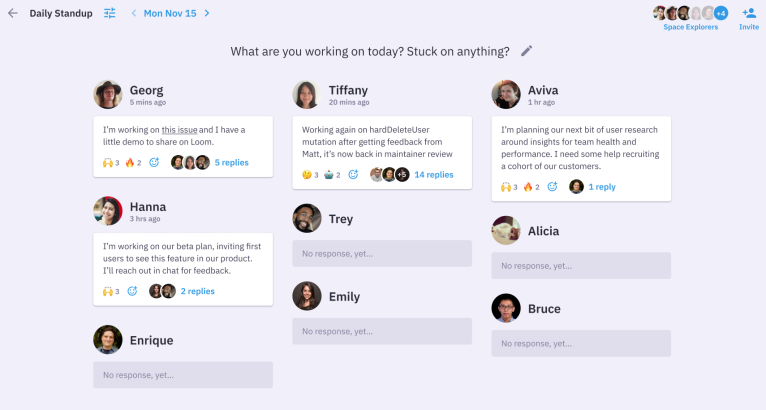Daily Scrum: Complete Beginner’s Guide

Daily Scrums are held by 87% of agile teams, making them the most popular of all Scrum events. Let’s review how you can make this popular Scrum event more productive, effective, and beneficial to your whole team.
What is the Daily Scrum meeting?
The Daily Scrum is a time-boxed, 15-minute meeting that is one of the five official Scrum events.
Scrum teams hold the Daily Scrum every day of a Sprint at the same time and in the same place, to reduce complexity. The Daily Scrum is also known as the “daily standup,” “daily huddle,”, “standup”, or simply “the daily”.
The term “standup” comes from the idea that when everyone is standing, it encourages the team to keep the meeting short.
Daily Scrum benefits and purpose
The Daily Scrum is used to inspect progress towards achieving the Sprint Goal and reduce the need for other ad-hoc gatherings that damage the focus of developers.
The goal of the meeting is to create clarity on the day’s work, adjust plans, and engage in some quick problem-solving.
Jeff Sutherland, inventor of the Scrum framework, compares the Daily Scrum to a sports team huddling before a match:
“The idea is for the team to quickly confer on how to move toward victory—i.e., complete the Sprint.” Like in sports, the team should leave the huddle feeling energized and clear on strategy and tactics for the day’s “match.”
The focus of the Daily Scrum should be on looking ahead at how to tackle the day and unblock one another, rather than giving status updates on what team members completed yesterday.

Who is required to attend the Daily Scrum?
The Daily Scrum is run by the developers of the Scrum team for the developers of the Scrum team. However, according to the Scrum Guide, “If the Product Owner or Scrum Master are actively working on items in the Sprint Backlog, they participate as Developers.”
Developers can hold the daily standup meeting by themselves, but a Scrum Master or other Agile Coach may facilitate it, especially when the team is new to Scrum. The Scrum Master may also coach the developers on how to make the Daily Scrum productive and how to keep it within the 15-minute time box.
What is the Scrum Master’s role in the Daily Scrum?
The Scrum Master may facilitate the Daily Scrum for teams that are new to running it. But generally the Scrum Master does not directly participate in the standup unless he or she is working as a developer in the sprint.
Product Owners should also not participate directly in the standup unless they have worked as a developer.
However, the Product Owner and other stakeholders are also allowed to attend as spectators if they are not participating in the sprint as Developers. They may want to do this to get a sense of how progress towards the Sprint Goal is going.
Daily Scrum agenda, format, and features
The Scrum Guide gives little guidance on the format of this popular meeting beyond its length, location, and who should attend.
Scrum does not specify a Daily Scrum agenda and says:
“Developers can select whatever structure and techniques they want.”
For remote or distributed teams who do not work in the same office, this may involve using an online tool.
💡 Need ideas to spice up your Daily Scrum’s format? Hop over to 14 Daily Standup Formats to Try With Your Team.
Daily Scrum duration and location
The Daily Scrum is a 15-minute time-boxed event held every working day of the Sprint at the same time and place.
This consistency reduces complexity makes the Daily Scrum the heartbeat of the Sprint. It also makes it easier for team members to plan their deep work around it.
Distributed teams can hold the meeting on Zoom or Microsoft Teams, and many opt to turn the event into an async practice using a dedicated online standup tool. Each team member then posts a daily update about their plans, progress, and blockers for the day.
The 3 Daily Scrum questions
Previous versions of the Scrum Guide prior to 2020 recommended three questions to ask during the daily standup. These questions are no longer prescribed by the guide, but many teams still use them to structure the meeting.
The three Daily Scrum questions are:
- What did you do yesterday?
- What will you do today?
- Are there any blockers or impediments preventing you from doing your work?
Teams typically go around a real or virtual circle, with members answering the three questions above one person at a time.
Three questions are a lot to answer. So if you’re using these guiding questions try this rule:
If you find yourself speaking for more than about 90 seconds, try to resolve the issue outside the meeting with your Scrum Master or team-mates.
6 tips for a great Daily Scrum
Without proper guardrails, Daily Scrums can transform from energizing team huddles into standing ordeals.
When that happens, developers come to hate the daily ritual because it’s a distraction instead of a productivity booster.
Here are 6 tips to make and keep your Daily Scrums great.
1. Enforce the Daily Scrum’s 15 mins time box
Because it happens daily, the Daily Scrum should be short and abide by Scrum’s mandated timebox. Most developers who hate the meeting – and there are many – will tell you it goes on for too long, too often.
When you do find development teams who like the Daily Scrum, it’s because they keep them short and helpful.
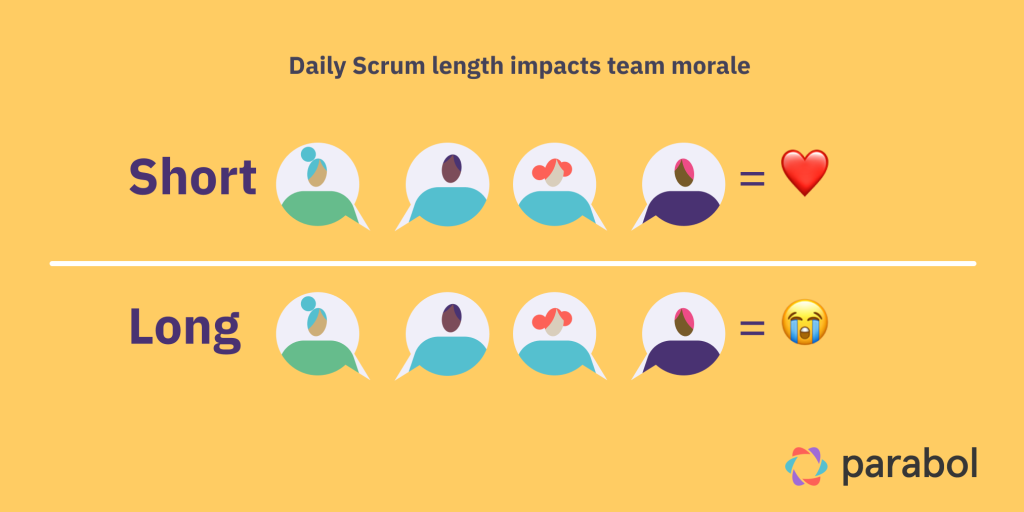
Time boxing can be relatively easy for smaller teams – just make sure you have a timer. Larger groups might find the 15-minute time limit harder to maintain. So, instead of just timing the meeting, time box individual updates too and keep them within one or two minutes.
⏱️ Scrum Masters or Facilitators : Don’t be afraid to use a physical stopwatch with your teams if they’re prone to running over the scheduled 15 minutes.
2. Experiment with ways to keep the event short
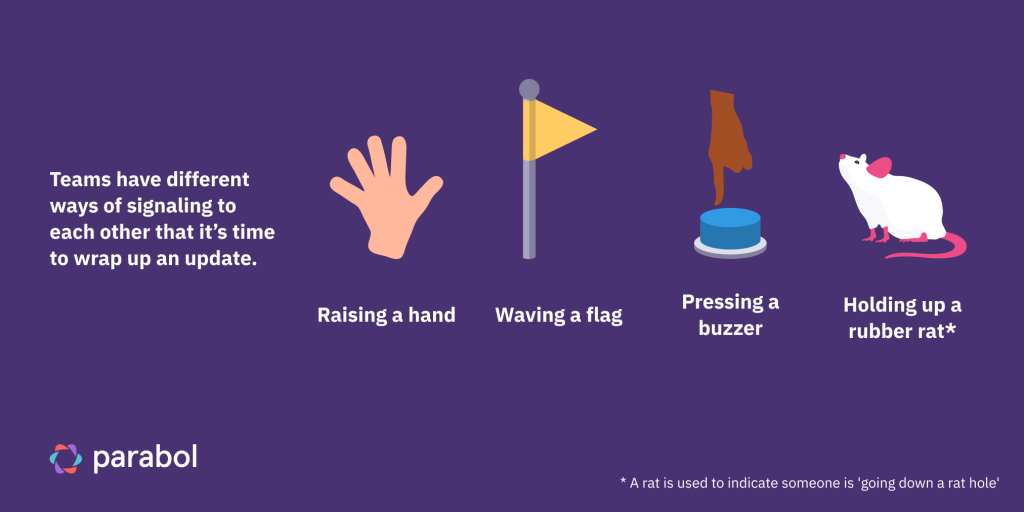
If standing and time boxing don’t keep things moving, here are more ways to stop the meeting from going into overtime. Depending on your viewpoint, some of these ideas border on the obnoxious – carefully assess whether they’re a fit for your team and culture.
- 🚩 Have rambling signals: When one person speaks for too long, some teams employ “buzzers, hold up rubber rats (to indicate someone is ‘going down a rat hole’), or even use an Elmo doll, indicating ‘Enough Let’s Move On.’”
- ☕️ Remove coffee: Put in place a “no coffee” rule. Nobody can enjoy their coffee until the meeting is over.
- 🏋🏿♀️ Add some weight: Let the person speaking hold a small medicine ball or dumbbell in front of them. If teammates aren’t all in the same office, consider giving each person or group their very own medicine ball for this.
- 🐦 Set a character limit: If you’re running standups with an online tool, impose a character limit to keep things short and sweet. Try setting a rule that daily updates should be no more than 500 characters – about the length of two tweets.
3. Create team ownership of the Daily Scrum
“Managers” should never interfere in the Daily Scrum or request status updates in that forum because then the meeting ceases to benefit the development team.
The Daily Scrum should be attended by developers to serve developers in their quest to meet the Sprint Goal.
To keep this from happening, some teams don’t allow the Scrum Master, Product Owner, or project manager to be the meeting facilitator.
Scrum trainer Mirko Perkusich sums it up:
“The Scrum Master’s only responsibility regarding the Daily Scrum is to make sure that it happens and to teach the team to conduct it effectively. … The faster the Scrum Master’s presence during Daily Scrums becomes useless, the better he did his job!”
Developers can also use their Sprint Retrospectives to debug the Daily Scrum if it’s somehow not helping them to improve their work.
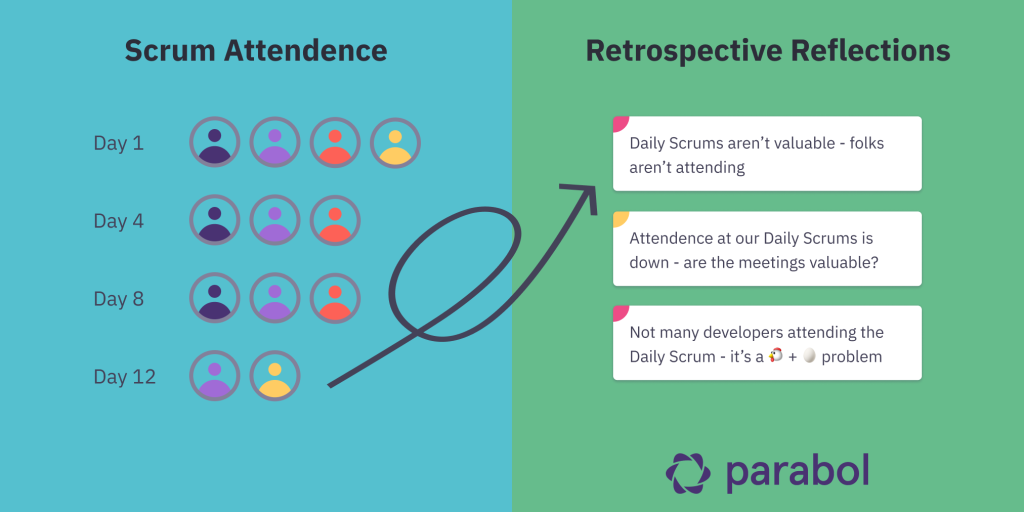
4. Be Agile and iterate on the questions or prompts used in your Daily Scrum
Since the Scrum Guide gives no template or other prescriptions on how to run this event, you can take an agile approach and iterate on the Daily Scrum itself.
The three questions from the old Scrum Guide make for a good starting point. But they’re not required, so you can adjust them as you please. For example:
- 💡 Try removing “What did you do yesterday?” to reduce the inclination to give status updates. Instead, people can answer this question asynchronously or other developers can look at the Scrum board.
- 💡 Try reporting blockers in advance – by message, in your Scrum board’s “stuck” column, or on a dedicated “improvement board“ – so you have more synchronous time for other topics.
- 💡 Try replacing “What’s changed?” with a more specific question to create focus, like “What are your two to three highlights from yesterday?”
- 💡 Try removing backward-looking questions and updates. Only look forward and focus on what you plan to do next and what stands in the way of achieving the Sprint Goal.
5. Optimize the Daily Scrum timeslot for maximum focus
One of the most common complaints about the Daily Scrum is that it forces developers to break their focus during the day. It takes time to regain complete focus after a distraction. Instead of lasting 15 minutes, a poorly timed Daily Scrum can easily distract developers for twice as long.
Remember, since the meeting serves developers, it should be developers who choose how they prefer to run the meeting.
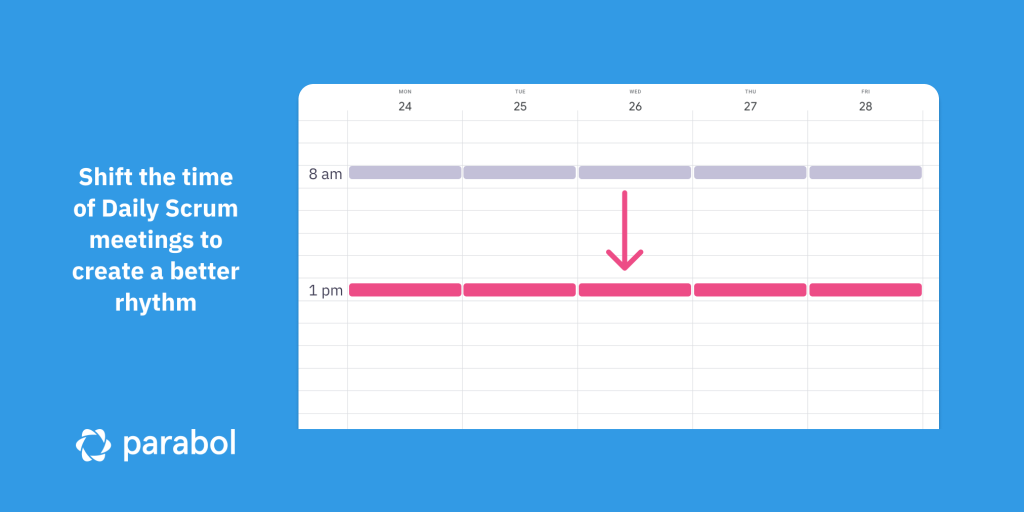
To prevent themselves waiting around for the Daily Scrum or struggling to focus after it, developers can consider trying these things:
- ☕ Start the day with the Daily Scrum: Many teams choose to start the day with the daily standup. This allows teams to have a full day of focus ahead of them after the meeting. While this may still mean the meeting is too early for some and too late for others, it’s hard to get it right for everyone.
- 🥪 Pre-lunch standups: Instead, consider holding the Daily Scrum just before lunch. This moment is a natural break in the day, so it doesn’t disrupt your team’s deep work. The prospect of lunch also gives everyone another reason to keep the meeting short. And team members who want to go in-depth on a topic can grab lunch together afterward.
- 🌐 Run the standup asynchronously: Remote, distributed, and even co-located teams may choose to run their standups asynchronously, using Slack or an online tool. This allows everyone to contribute their update in their own time. This method works particularly well for distributed teams where developers in China, for example, are ending their days as developers in the US wake up.
💡 Learn more about the benefits and pitfalls of async standups in Virtual vs Async Standups: Which is Right For Your Team?
6. Focus on work in progress rather than individual contributions
To maintain focus on achieving the Sprint Goal, make your Daily Scrum about the work progress instead of individual updates.
Talk through sprint backlog items on the task board in order of importance or completion status, and let people comment on those items. This approach means one person might speak several times during a meeting instead of just once.
Daily Scrums motivate teams and strengthen sprints
Scrum founder Jeff Sutherland said that the meeting should create teams that:
“…come out of the daily meeting knowing the most important thing they need to accomplish that day… I want teams emerging from that meeting saying things like, ‘Let’s nail this. Let’s do this.’ The team needs to want to be great.”
Daily Scrums can energize your team and form the glue between the other Scrum events – sprint planning, sprint reviews, and retrospectives. When done right, they become the equivalent of a sports team huddling before a match. Members walk out of the meeting motivated with a clear sense of what they need to do.
💡 Check out our Daily standup hub for an overview of all our resources on daily standups.
Daily Scrum FAQs
What is the difference between a Daily Scrum vs. standup?
Most people who speak about a daily standup refer to the Daily Scrum and vice versa. In some cases, a standup meeting is just a get-together where people stand instead of sit, even when it’s not a Scrum event or other agile meeting.
As mentioned earlier, it is sometimes called the Daily Huddle, the daily or simply a standup. Its purpose is to keep the team focused on progressing toward the Sprint Goal (often referred to as the product increment).
Who starts the Daily Scrum?
The Daily Scrum’s facilitator is often the team’s Scrum Master. However, the meeting doesn’t require a facilitator. The meeting is held by developers for developers. So as a Scrum team becomes more mature and truly self-managing, the developers should be able to organize and facilitate this meeting among themselves.
Is there a Daily Scrum meeting checklist or template?
The Daily Scrum is a short event without much official structure. Since the Scrum Guide remove the three guiding questions in 2020, there is even less structure.
You can use the checklist below to ensure a smooth and effective daily meeting:
- 🤝 Agree a consistent time, place, or async routine for the event.
- 🤖 If working remotely or asynchronously, agree an online standup tool to try.
- ⏱️ Set your timer for 15 minutes to abide by the Daily Scrum timebox.
- ❓ Start with the three Daily Scrum questions.
- 💬 Discuss ways to improve your Daily Scrums during sprint retrospectives.
- ♻️ Iterate your approach how ever suits you best to inspect progress towards the Sprint Goal.
Iterating on your Daily Scrum process may involve introducing new questions, new tools, or even trying an asynchronous standup process.

